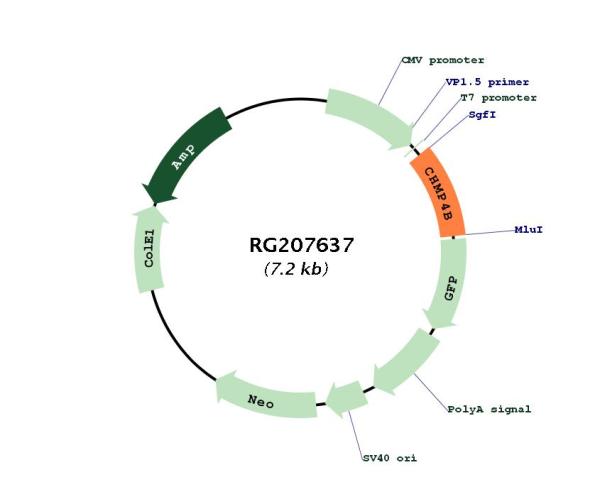CHMP4B (NM_176812) Human Tagged ORF Clone
CAT#: RG207637
- TrueORF®
CHMP4B (tGFP-tagged) - Human chromatin modifying protein 4B (CHMP4B)
ORF Plasmid: DDK
Lentiviral Particles: DDK DDK w/ Puro mGFP mGFP w/ Puro
AAV Particle: DDK
"NM_176812" in other vectors (7)
Specifications
| Product Data | |
| Type | Human Tagged ORF Clone |
| Tag | TurboGFP |
| Symbol | CHMP4B |
| Synonyms | C20orf178; CHMP4A; CTPP3; CTRCT31; dJ553F4.4; Shax1; SNF7; SNF7-2; Vps32-2; VPS32B |
| Vector | pCMV6-AC-GFP |
| E. coli Selection | Ampicillin (100 ug/mL) |
| Mammalian Cell Selection | Neomycin |
| Sequence Data |
>RG207637 representing NM_176812
Red=Cloning site Blue=ORF Green=Tags(s) TTTTGTAATACGACTCACTATAGGGCGGCCGGGAATTCGTCGACTGGATCCGGTACCGAGGAGATCTGCC GCCGCGATCGCC ATGTCGGTGTTCGGGAAGCTGTTCGGGGCTGGAGGGGGTAAGGCCGGCAAGGGCGGCCCGACCCCCCAGG AGGCCATCCAGCGGCTGCGGGACACGGAAGAGATGTTAAGCAAGAAACAGGAGTTCCTGGAGAAGAAAAT CGAGCAGGAGCTGACGGCCGCCAAGAAGCACGGCACCAAAAACAAGCGCGCGGCCCTCCAGGCACTGAAG CGTAAGAAGAGGTATGAGAAGCAGCTGGCGCAGATCGACGGCACATTATCAACCATCGAGTTCCAGCGGG AGGCCCTGGAGAATGCCAACACCAACACCGAGGTGCTCAAGAACATGGGCTATGCCGCCAAGGCCATGAA GGCGGCCCATGACAACATGGACATCGATAAAGTTGATGAGTTAATGCAGGACATTGCTGACCAGCAAGAA CTTGCAGAGGAGATTTCAACAGCAATTTCGAAACCTGTAGGGTTTGGAGAAGAGTTTGACGAGGATGAGC TCATGGCGGAATTAGAAGAACTAGAACAGGAGGAACTAGACAAGAATTTGCTGGAAATCAGTGGACCCGA AACAGTCCCTCTACCAAATGTTCCCTCTATAGCCCTACCATCAAAACCCGCCAAGAAGAAAGAAGAGGAG GACGACGACATGAAGGAATTGGAGAACTGGGCTGGATCCATG ACGCGTACGCGGCCGCTCGAG - GFP Tag - GTTTAA >RG207637 representing NM_176812
Red=Cloning site Green=Tags(s) MSVFGKLFGAGGGKAGKGGPTPQEAIQRLRDTEEMLSKKQEFLEKKIEQELTAAKKHGTKNKRAALQALK RKKRYEKQLAQIDGTLSTIEFQREALENANTNTEVLKNMGYAAKAMKAAHDNMDIDKVDELMQDIADQQE LAEEISTAISKPVGFGEEFDEDELMAELEELEQEELDKNLLEISGPETVPLPNVPSIALPSKPAKKKEEE DDDMKELENWAGSM TRTRPLE - GFP Tag - V |
| Restriction Sites |
SgfI-MluI
Cloning Scheme for this gene
Plasmid Map

|
| ACCN | NM_176812 |
| ORF Size | 672 bp |
| OTI Disclaimer | The molecular sequence of this clone aligns with the gene accession number as a point of reference only. However, individual transcript sequences of the same gene can differ through naturally occurring variations (e.g. polymorphisms), each with its own valid existence. This clone is substantially in agreement with the reference, but a complete review of all prevailing variants is recommended prior to use. More info |
| OTI Annotation | This clone was engineered to express the complete ORF with an expression tag. Expression varies depending on the nature of the gene. |
| Product Components | The ORF clone is ion-exchange column purified and shipped in a 2D barcoded Matrix tube containing 10ug of transfection-ready, dried plasmid DNA (reconstitute with 100 ul of water). |
| Reconstitution | 1. Centrifuge at 5,000xg for 5min. 2. Carefully open the tube and add 100ul of sterile water to dissolve the DNA. 3. Close the tube and incubate for 10 minutes at room temperature. 4. Briefly vortex the tube and then do a quick spin (less than 5000xg) to concentrate the liquid at the bottom. 5. Store the suspended plasmid at -20°C. The DNA is stable for at least one year from date of shipping when stored at -20°C. |
| Reference Data | |
| RefSeq | NM_176812.5 |
| RefSeq Size | 1685 bp |
| RefSeq ORF | 675 bp |
| Locus ID | 128866 |
| UniProt ID | Q9H444 |
| Cytogenetics | 20q11.22 |
| Protein Pathways | Endocytosis |
| Gene Summary | This gene encodes a member of the chromatin-modifying protein/charged multivesicular body protein (CHMP) protein family. The protein is part of the endosomal sorting complex required for transport (ESCRT) complex III (ESCRT-III), which functions in the sorting of endocytosed cell-surface receptors into multivesicular endosomes. The ESCRT machinery also functions in the final abscisson stage of cytokinesis and in the budding of enveloped viruses such as HIV-1. The three proteins of the CHMP4 subfamily interact with programmed cell death 6 interacting protein (PDCD6IP, also known as ALIX), which also functions in the ESCRT pathway. The CHMP4 proteins assemble into membrane-attached 5-nm filaments that form circular scaffolds and promote or stabilize outward budding. These polymers are proposed to help generate the luminal vesicles of multivesicular bodies. Mutations in this gene result in autosomal dominant posterior polar cataracts.[provided by RefSeq, Oct 2009] |
Documents
| Product Manuals |
| FAQs |
| SDS |
Resources
Other Versions
| SKU | Description | Size | Price |
|---|---|---|---|
| RC207637 | CHMP4B (Myc-DDK-tagged)-Human chromatin modifying protein 4B (CHMP4B) |
USD 300.00 |
|
| RC207637L1 | Lenti ORF clone of Human chromatin modifying protein 4B (CHMP4B), Myc-DDK-tagged |
USD 600.00 |
|
| RC207637L2 | Lenti ORF clone of Human chromatin modifying protein 4B (CHMP4B), mGFP tagged |
USD 600.00 |
|
| RC207637L3 | Lenti ORF clone of Human chromatin modifying protein 4B (CHMP4B), Myc-DDK-tagged |
USD 600.00 |
|
| RC207637L4 | Lenti ORF clone of Human chromatin modifying protein 4B (CHMP4B), mGFP tagged |
USD 600.00 |
|
| SC106955 | CHMP4B (untagged)-Human chromatin modifying protein 4B (CHMP4B) |
USD 450.00 |
|
| SC322662 | CHMP4B (untagged)-Human chromatin modifying protein 4B (CHMP4B) |
USD 450.00 |
{0} Product Review(s)
Be the first one to submit a review






























































































































































































































































 Germany
Germany
 Japan
Japan
 United Kingdom
United Kingdom
 China
China

